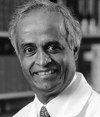Perspective: Ayurveda and Conventional Medicine

Bala V. Manyam, M.D.
Bala V. Manyam, M.D., is a member of NCCAM's National Advisory Council for Complementary and Alternative Medicine. Dr. Manyam is retired director of the Plummer Movement Disorders Center, Scott & White Clinic, Temple, Texas, and professor emeritus at Texas A&M University System Health Science Center College of Medicine. He received his medical degree from Bangalore Medical College, in India, and did his neurology residency at the Medical College of Wisconsin, Milwaukee, and Thomas Jefferson University, Philadelphia (where he also held a pharmacology fellowship). Currently, Dr. Manyam is researching Ayurvedic herbal medicines, especially for degenerative neurological disorders such as Alzheimer's disease. In a recent interview, Dr. Manyam offered his personal perspective on Ayurveda.
Q: What are some reasons that people in the United States become interested in Ayurveda?
A: Many patients with chronic diseases find that conventional drugs can have significant side effects. Also, some patients are seeking preventive and health-promotion benefits (two things that Ayurveda focuses upon).
Q: What is your philosophy about using Ayurveda versus conventional medicine?
A: I have an open mind. I believe that all health/healing systems have merits and demerits. I look at the good things in each system that I think could do the best for my patients or me. I also believe that just because a particular therapy was stated as effective in an ancient text and has been continuously used, does not mean it is effective. We should not blindly accept it. It should be tested and retested over the years.
Q: Are there variations in practice within Ayurveda in the United States?
A: I am not aware of any studies to precisely answer this question. There are very few qualified Ayurvedic physicians in the United States. Some naturopathic doctors and doctors who are M.D.s have incorporated some Ayurvedic approaches into their practices. Thus, the practice is variable.
Q: What are some challenges that need to be met if Ayurveda is to move further toward becoming part of integrative medicine in the United States?
A: The biggest challenge is obtaining standardized, reliable Ayurvedic products. In ancient times, and still in rural India, the physician would identify and prepare fresh formulations for patients. Now, however, a long shelf life is necessary. It is very difficult to do this, as botanicals contain many compounds besides the so-called "active" compound, and their shelf lives can be variable. For example, the base ingredient of Chavanprash, a health tonic, traditionally is Emblica officinalis, or gooseberry. However, modern formulations often use sweet potato and very little gooseberry, because sweet potato keeps better due to its sugar content.
Second, it can be misunderstood how metals are used in some Ayurvedic preparations. In some preparations, there is a metallic component in the form of a metallic oxide (or bhasma). These medications must be prepared in a prescribed, rigid manner in order to be as safe as possible.
Third, physicians in Ayurveda must be adequately trained. In one estimate, at least 200 hours of Ayurvedic training are needed for an allopathic physician to acquire enough knowledge to adequately integrate Ayurveda into his or her practice.
